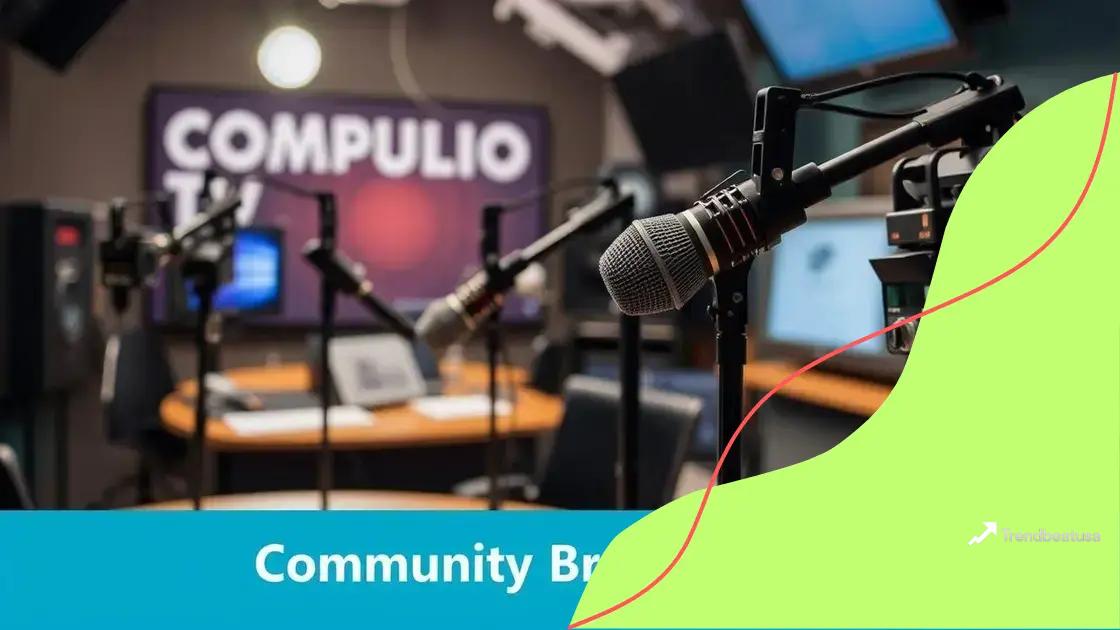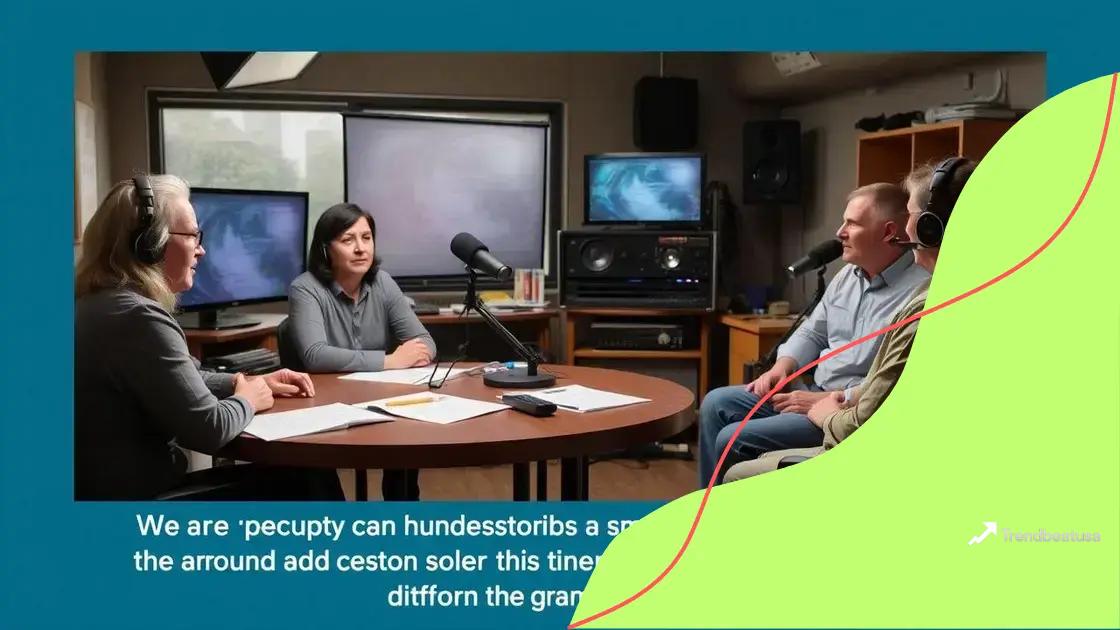Public broadcasting funding cuts announced: what’s next?

The future of public broadcasting in America relies on adapting to digital trends, enhancing community engagement, and exploring innovative funding strategies to remain relevant and serve local audiences effectively.
Public broadcasting funding cuts announced have raised concerns across the nation. These changes could affect how many communities receive crucial news and cultural programming. Let’s dive into what these cuts mean for you.
Overview of public broadcasting funding
Public broadcasting has long been a vital source of news, education, and entertainment. An overview of public broadcasting funding reveals how it is structured and why it matters. Understanding this funding is essential for grasping the implications of recent cuts.
Sources of Funding
Public broadcasting receives funds from various sources. The main ones include:
- Federal appropriations: The government allocates funds to support public broadcasting.
- State and local funding: States and municipalities often contribute to local stations.
- Donations: Fundraising and membership contributions play a large role.
- Corporate sponsorships: Businesses may sponsor programs for visibility and support.
This diverse funding mix is crucial for the survival of many public broadcasting services. When any of these sources are impacted, the effects can ripple through the entire system. For example, a drop in federal funding can lead to significant cutbacks in programming.
The importance of local stations cannot be overstated. They often serve specific communities and provide localized content. This content helps to strengthen community ties and keeps residents informed about important local issues. Losing this service would mean a gap in community engagement and awareness.
Current Challenges
Public broadcasting is facing unique challenges today. With shifts in consumer behavior and media consumption, many traditional funding sources are dwindling. Audiences increasingly seek content online, which may not always translate to financial support for public broadcasting.
Additionally, political pressures can significantly affect funding allocations. As discussions around budget cuts to public broadcasting heat up, understanding the broader implications can provide crucial context. How will reduced funding affect the diversity of programming? Will local news quality decline? These questions warrant serious consideration.
In summary, the overview of public broadcasting funding illustrates the complexity and importance of financial support for these services. As the landscape evolves, staying informed about changes and challenges is more important than ever.
Current policies behind funding cuts
The current policies behind funding cuts to public broadcasting are critical to understand. These policies influence how much support public stations receive from various sources. As funding allocations become tighter, it’s important to examine where these cuts stem from.
Federal Budget Considerations
At the federal level, decisions are made annually regarding how much funding will be allocated to public broadcasting. Many lawmakers view this funding as discretionary. As a result, it can be among the first areas to face budget cuts during times of financial strain. Budget proposals often reflect priorities and can shift based on the political landscape.
Furthermore, while some lawmakers advocate for continued support, others argue for reduction, claiming taxpayer funds should not support specific programming. This creates an ongoing debate about the role of public broadcasting in a digital age.
Impact of Local Government Policies
Local governments also play a vital role in public broadcasting funding. Many stations rely on state and local funding to operate. When local budgets are tight, these stations may find themselves competing with other essential services.
- State budgets: If a state prioritizes education or infrastructure over media, public broadcasting can suffer.
- Local funding cuts: Reductions at the county or city level can severely impact smaller stations.
- Public perception: Community support can influence local funding decisions, meaning public opinion matters greatly.
Another crucial factor is the changing technology landscape. As more viewers turn to streaming services and digital platforms, many funders question the relevance of traditional public broadcasting. This shift can lead to decreased financial support as funders try to align with viewer preferences.
Overall, examining the current policies behind funding cuts reveals a web of political, financial, and societal factors. As these conditions evolve, so will the future of public broadcasting, making it crucial to stay informed about the dynamics at play.
Impacts of funding cuts on local stations

The impacts of funding cuts on local stations are both significant and diverse. These cuts can drastically change the landscape of public broadcasting in communities across the country. Local stations usually rely on a combination of federal, state, and local funding, as well as donations from listeners.
Reduced Programming and Services
One immediate effect of funding cuts is reduced programming. With less money to work with, local stations may have to choose between keeping popular shows or investing in new content. This could lead to:
- Increased reruns: Stations might air older episodes to fill schedules.
- Fewer local reports: Coverage of local events and news may diminish.
- Loss of unique cultural programming: Specialty shows that highlight local artists and events may not survive.
As a result, listeners and viewers may feel disconnected from their community. Without vibrant and diverse programming, local stations may struggle to attract and retain audiences.
Impact on Employment
Funding cuts can also lead to job losses within local stations. Many smaller stations operate with tight budgets, and a reduction in funding often means fewer staff members. These layoffs affect not only on-air talent but also support staff such as:
- Producers: Those who develop and create content.
- Technicians: Individuals responsible for maintaining equipment and broadcasting.
- Administrative staff: The teams managing overall operations and fundraising efforts.
With fewer employees, local stations may struggle to maintain operational standards, leading to compromised service across the board.
Community Engagement Issues
Local stations play a crucial role in fostering community engagement. Funding cuts can lead to fewer opportunities for community outreach and involvement. Events like town halls, educational programs, and local arts initiatives might be reduced or eliminated. This can weaken the bond between the public and their local broadcasters, making it harder for communities to engage with important issues.
In summary, understanding the impacts of funding cuts on local stations provides insight into the fragility of public broadcasting. As funding sources dwindle, these stations face significant challenges that affect not only their operations but also the communities they serve.
Community response to proposed changes
The community response to proposed changes in public broadcasting funding is critical to understand. As funding cuts are announced, community members often express their concerns and opinions about the impact on local stations. This response can take many forms, from public protests to online petitions.
Public Outcry
One of the most visible responses is public outcry. When funding cuts are proposed, many community members feel a sense of loss. They may organize rallies or write letters to local representatives. Such actions help to express the collective concern about the potential loss of beloved programming. People often feel connected to their public broadcasting stations, which serve to inform and entertain.
Online Movements
In today’s digital age, many community members take their concerns to social media. Online movements can raise awareness quickly, mobilizing supporters across different platforms. Petitions can gather thousands of signatures, urging local governments and decision-makers to reconsider their funding cuts. These online efforts can pressure officials to prioritize public broadcasting funding.
- Social media campaigns: Hashtags can create movements that draw attention to the issue.
- Virtual town halls: Community members may host discussions online to share their thoughts.
- Videos and testimonials: Personal stories can illustrate the importance of local stations to individuals.
The reaction from local businesses can also play a significant role. Many local businesses that rely on advertising through public broadcasting may express support for maintaining funding. They recognize the importance of having a strong local voice within the media. When businesses speak out, it can enhance the community’s push for funding preservation.
Engagement with Policymakers
Another vital aspect of community response is engaging with policymakers. Residents often encourage local leaders to prioritize public broadcasting in budget discussions. Organized groups may meet with city council members to share their perspectives. They emphasize the value these stations provide in distributing local news and cultural programming.
This engagement can lead to changes in how funding decisions are made. When communities unite to voice their concerns, it becomes harder for policymakers to ignore their needs. In this way, the community response to proposed changes in broadcasting funding can significantly influence future funding distributions.
Future of public broadcasting in America
The future of public broadcasting in America is uncertain yet holds potential for innovation and adaptation. As the media landscape rapidly evolves, public broadcasting must find new ways to engage audiences and secure funding. This change is crucial for survival amidst increasing competition from digital platforms.
Adapting to Digital Trends
One key aspect of the future is adapting to digital trends. Many viewers and listeners now prefer on-demand content that can be accessed anytime. To remain relevant, public broadcasting stations are exploring ways to expand their digital presence. This includes:
- Creating mobile apps: These apps allow users to access live broadcasts and on-demand content.
- Enhancing social media engagement: Stations use platforms like Facebook and Twitter to connect with younger audiences.
- Streaming services: Many are considering partnerships with existing streaming platforms to reach wider audiences.
By embracing technology, public broadcasting can retain its role in providing quality content while reaching new viewers.
Community Engagement
Another focus for the future is community engagement. Local stations can strengthen ties with their communities by creating localized content. This could involve:
- Highlighting local events: Covering community happenings keeps residents informed and engaged.
- Inviting community input: Stations can gather feedback through town halls or surveys to understand what audiences want.
- Collaborating with local organizations: Partnering with schools and nonprofits can enhance programming and outreach efforts.
By fostering these connections, public broadcasting can ensure that they remain a vital part of community life.
Funding Innovations
The future of funding is another vital consideration. Public broadcasting must explore innovative funding strategies to replace lost revenue. This might include:
- Corporate sponsorships: Building relationships with businesses can provide additional funding.
- Crowdfunding initiatives: Engaging audiences through crowdfunding can offer a direct source of support.
- Expanding grant applications: Actively seeking grants from arts and culture organizations can help secure necessary financial resources.
These innovative approaches can create a more sustainable financial future for public broadcasting in America.
Overall, the future of public broadcasting in America will greatly depend on its ability to adapt and evolve in a changing media environment. By embracing technology, enhancing community engagement, and exploring diverse funding options, public broadcasting can continue to thrive and serve the public interest for years to come.
In conclusion, the future of public broadcasting in America hinges on its ability to adapt to changing landscapes and community needs. By embracing digital trends, fostering community connections, and pursuing innovative funding strategies, public stations can remain vital resources for information and culture. These steps will help ensure that public broadcasting continues to thrive and serve the public even in challenging times.
FAQ – Questions About the Future of Public Broadcasting in America
How is public broadcasting adapting to digital trends?
Public broadcasting is creating mobile apps and enhancing social media engagement to reach wider audiences and provide on-demand content.
What role does community engagement play in public broadcasting?
Community engagement is crucial as it strengthens ties through localized content and allows stations to gather input on what audiences want.
What innovative funding strategies are public broadcasting stations considering?
Stations are exploring corporate sponsorships, crowdfunding initiatives, and expanding grant applications to secure necessary financial resources.
Why is the future of public broadcasting important for local communities?
The future of public broadcasting is vital as it provides essential information, cultural programming, and supports community connection and involvement.
